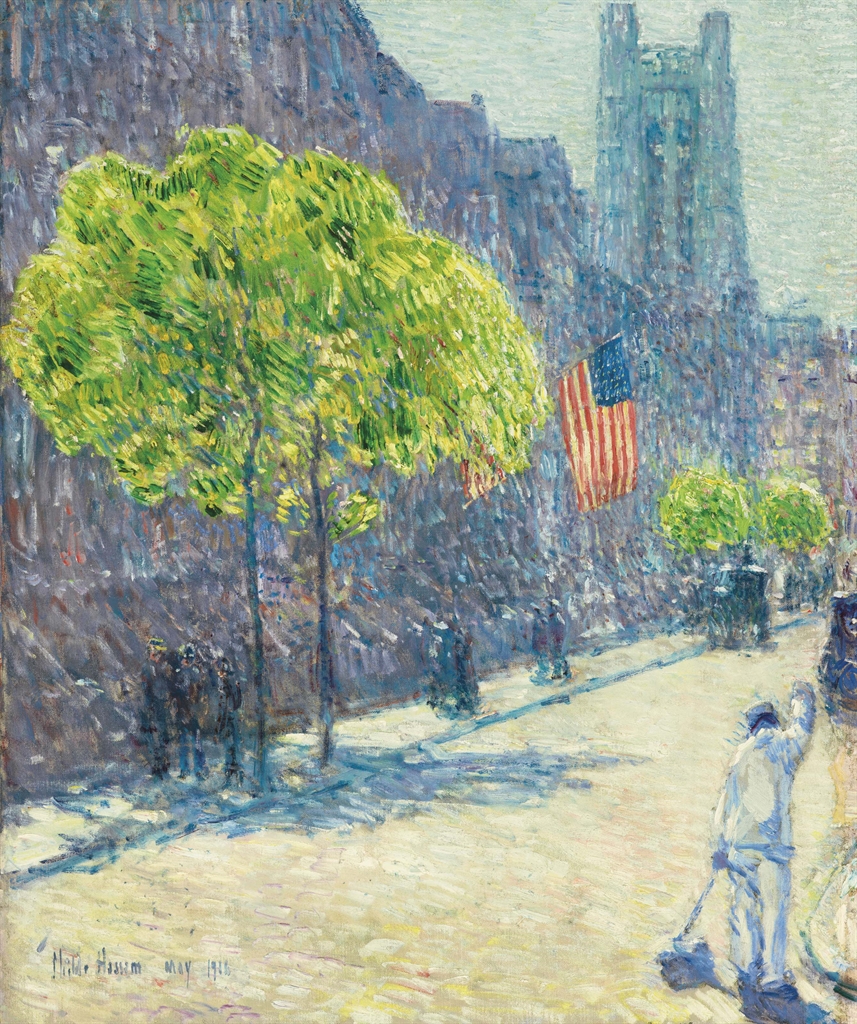5 minutes with… A Childe Hassam flag painting
The first picture from the artist’s iconic flag series was offered in the American Art sale on 23 May at Christie’s in New York. American Paintings specialist Jennifer Jacobsen explains its greater significance
Born in Dorchester, Massachusetts (now Boston), Childe Hassam (1859-1935) became perhaps the most popular of all American Impressionist artists. He studied in Paris from 1886 to 1889, where he was drawn to the work of the French Impressionists.
Returning to America, he applied the radical techniques and aesthetics he discovered on the Continent to the cities of his native country, making frequent studies of Boston and New York. Hassam's interest in the urban landscape made him somewhat unusual among his American Impressionist contemporaries.
‘After his time in Paris,’ explains Jennifer Jacobsen, American Paintings specialist at Christie’s New York, ‘Hassam’s brushstrokes and hues begin to mimic those of the French Impressionists, particularly Monet and Pissarro.’ He was also inspired by their images of the flags and banners displayed around Paris on Bastille Day.
Just Off the Avenue, Fifty-third Street, May 1916 is the first work in the series of flag paintings that came to define his later career. ‘At the time this was painted, Hassam had already achieved success,’ says Jacobsen, ‘and this series became arguably the most famous depiction of New York in American Impressionism.’
The full flag series, comprising some 30 oils and additional watercolours, was displayed in exhibitions following the First War World — beginning with a show at the Durand-Ruel Galleries in New York just days after the signature of the Armistice in 1918.
Childe Hassam (1859-1935), Just Off the Avenue, Fifty-third Street, May 1916. Oil on canvas. 31¼ x 26½ in (79.4 x 67.3 cm). Sold for $2,407,500 on 23 May 2017 at Christie’s in New York
The series was directly inspired by the Preparedness Parade of 13 May, 1916, the first major public demonstration of American involvement in Europe prior to its entry into the First World War in April 1917. Some 137,000 people thronged the parade, which spanned the length of Fifth Avenue from 23rd to 58th Street and lasted nearly 13 hours. In the war years, Hassam’s studio was located at the end of the parade route, on West 57th street, which kept the artist in close proximity to the American flags that hung from nearby buildings.
Over time, says Jacobsen, the paintings evolve into very elaborate images, with dozens of flags soaring down New York’s avenues. Just Off the Avenue, Fifty-third Street, May 1916 is a subtler composition, showing a quiet street with just one flag, suggesting what is to come. Notably, Just Off the Avenue, Fifty-third Street, May 1916 depicts the daily life of the upper class in refined New York neighbourhoods, a subject Hassam returned to throughout his career.
‘The White House has owned a painting from the series since the Kennedy administration, and the Obama administration chose to hang this work in the Oval Office’
Interestingly, adds Jacobsen, even if the American flags were intended as parade decorations, Hassam avoids depicting parades in the series because he didn’t want to ‘box in’ the paintings by tying them to specific, identifiable events; by the series' end, Hassam’s flags have become broader symbols of American patriotism.
The specialist goes on to underline the enduring interest in Hassam’s series: ‘The White House has owned one since the Kennedy administration, and the Obama administration chose to hang this work in the Oval Office.’
The depiction of Fifty-third Street appeals to Jennifer Jacobsen on a personal level, too: ‘The street where this work was painted — so close to the Christie’s office at Rockefeller Center — is one that I regularly go down, and has changed drastically. This was a modern scene in Hassam’s day, and now the block is the site of the Museum of Modern Art!’
